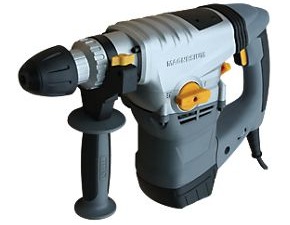SDS drills
Buying an SDS drill for DIY has the potential to be an expensive activity, and one which is not altogether necessary, if you have a good quality cordless combi drill, or standard power drill. Therefore before taking the plunge, I’ve put together a few points to explain exactly what extra an SDS drill has to offer, and tell you what I feel is the best DIY SDS drill on the market, which also happens to be one of the cheapest.
What is an SDS drill?
Just to clarify what an SDS drill is, it’s basically a more heavy duty option to traditional twist, or power drills, and is mainly used for drilling into masonry surfaces. Although cordless combi drills, or standard power drills can be used for drilling into masonry, they will be much slower than an SDS drill, struggle more with the process, and are therefore more likely to break or burn out with prolonged use. So, for occasional drilling into masonry, combi drills or standard power drills are sufficient – anything more than that and you need an SDS drill. The extra power of the SDS drill is provided by a special hammering action whilst the drill bit rotates, which is simply more efficient and powerful than the action of traditional drills.
The SDS drill bits are different to normal bits and are characterised by their bulbous end which is both simple to push in, and release, from the socket-type chuck of the drill. Therefore, you can only use SDS drill bits with SDS drills. To make matters slightly more complicated, you will also see SDS Plus and SDS Max drills and bits. Basically, standard SDS bits and SDS Plus bits will fit both Standard SDS and SDS Plus drills. SDS Max drills and bits are heavier duty items (bits have a larger shank) so they won’t fit either standard SDS or SDS Plus drills.
SDS drill uses
Apart from being the easiest way of drilling into masonry and concrete, you can also use them with SDS auger bits for drilling large holes in wood. This is an option I’ve gone for many times when fitting a new lock or latch into a door, for example, but you do need to remember when drilling into wood, to use the non-hammer function.
However, the most useful ‘extra’ with the majority of SDS drills is the ability to use them as a demolition tool. ‘Three function’ SDS drills have a chipping hammer mode which basically stops the drilling action, and just uses the hammering backward and forward action. Therefore, this comes in incredibly useful for many demolition needs such as removing tiles (from walls or floors), removing old render and plaster from walls, or even knocking down old walls.
Corded or cordless SDS drills
Apart from the portability aspect, the clear difference between corded and cordless SDS drills is the price. You can buy good quality corded options for under £100, but for an ‘adequate’ cordless SDS drill you’re looking at £400 plus, and for anything ‘mmmm yes please’ you’re looking at £500-£800. Cordless options are therefore more of a professional tool, and a real DIY luxury, unless you are at the very serious end of the DIY scale.
If you do want to go for cordless, personally I’ve always had no trouble with the Makita models, although I am tempted to opt for Bosch when renewal time comes around again. One note of caution with cordless SDS drills is that although they generally have the chipping hammer option, I wouldn’t recommend prolonged use. Personally, I don’t think cordless drills, however large, like to be used for demolition, and this is a good reason for buying a corded SDS drill, which I think copes much better when essentially being used as a battering ram.
My SDS drill choice
Therefore without further ado, for me, the best SDS drill for DIY use (and arguably professional use), is a corded beast of a machine manufactured by Titan. The Titan 5Kg SDS plus drill (pictured right) is available at Screwfix, and has served me incredibly well over the years. It’s not pretty, not light, and therefore gives you a free aerobic workout with each use, but for performance and price, it simply leaves all others in its wake.
So if you’ve been looking through the many SDS drills available on the market, save yourself anymore time and opt for the Titan – I certainly wouldn’t be without mine.

